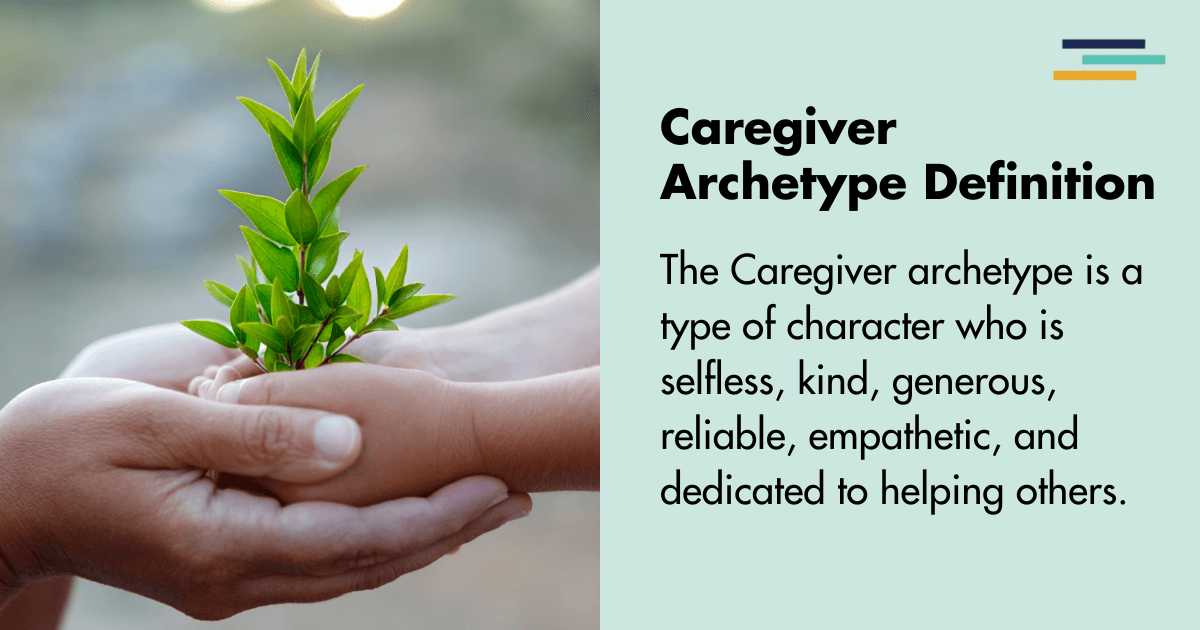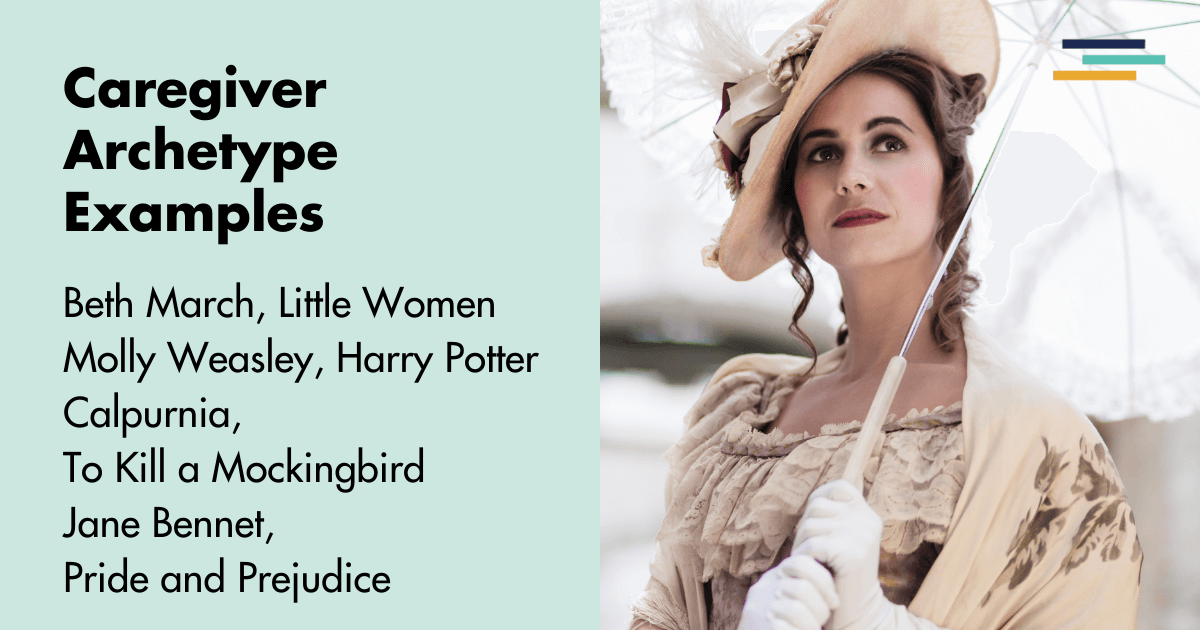
Derived from the studies of psychologist Carl Jung, the term archetype describes a literary device used to create a character based on a universal, instinctual set of traits and behaviors.
These archetypes, such as the hero, lover, or ruler, represent basic human motivations and personalities and are present in literature, film, and everyday life.
The caregiver archetype is selfless and committed to helping others. Learn more about what a caregiver archetype is, see examples from tv and literature, and explore 8 tips for writing these characters.
Take a free trial of Fictionary today and take your story to the next level.
What is the Caregiver Archetype?
The Caregiver archetype is characterized by selflessness, kindness, generosity, and dedication to helping others. These characters are altruistic, empathetic, and reliable. Their key traits include:
- Self-Sacrificing: They prioritize the needs of others, demonstrating a selfless nature.
- Generous: They are willing to share whatever resources they have with others. Their generosity knows no bounds.
- Compassionate: They are highly attuned to the emotions and needs of others.
- Empathetic: They show great empathy and understanding. They work to put themselves in the shoes of others.
- Optimistic: They maintain a positive attitude and are quick to forgive. Holding a grudge is not in their nature.
- Humble: Their humility allows them to serve others without seeking recognition or gratitude.
- Trustworthy, Reliable: In times of need, caregivers deliver. Their consistency and reliability make them a stable presence in others’ lives.
- Protective, Nurturing: Caregivers strive to protect and nurture others. It is common for them to adopt a maternal or paternal role, offering comfort, advice, and security.
- Patient, Kind-hearted: They exhibit patience, thoughtfulness, and humanity. They are quick to lend a helping hand or a shoulder to lean on.
- Gullible: Because they tend to see the good in others, they can be easily deceived.
- Intrusive: Sometimes caregivers overdo their good deeds, becoming overprotective and bothersome.

Caregiver Archetype Examples in Movies
Samwise Gamgee, Lord of the Rings
Sam is known for his dedication to Frodo and the mission to destroy the Ring. Initially reluctant to leave the Shire, Sam serves as Frodo’s loyal companion, consistently putting Frodo’s needs above his own.
By providing emotional and physical support throughout their perilous journey, Sam gives Frodo the strength to complete the quest. Though he is an ordinary individual, Sam’s unwavering friendship and loyalty are vital to Frodo’s success.
Marlin, Finding Nemo
Nemo’s overeager father doesn’t know when to stop parenting and let his son think for himself. After the tragic loss of his mate, he’s become overprotective and fearful, and when Nemo is captured, he must tap into his parental love and bravery to save him.
Oskar Schindler, Schindler’s List
Initially a war profiteer and member of the Nazi Party during the Holocaust, Oskar Schindler witnesses the atrocities being committed and undergoes a moral awakening.
This leads him to risk his own life to save the lives of over a thousand Jewish refugees when he employs them in his factories. He demonstrates a deep sense of responsibility and humanity while protecting his workers.
Joyce Byers, Stranger Things
Single mom Joyce is defined by her fierce dedication to her son, Will. When he mysteriously disappears, she relentlessly confronts danger and remains steadfast in her belief that Will is still alive, despite the supernatural forces working against her. She shows perseverance, faith, and the power of a mother’s love.
Claire Randall, Outlander
During a visit to a mysterious circle of standing stones, Claire is suddenly transported back in time to the mid-18th century. While she struggles to navigate life in 1743 Scotland, her background as a nurse and her nurturing nature motivate her to help and heal those she encounters.
She shows loyalty and kindness as she grapples with feeling love for a Scottish hero and her dedication to the husband she left in the future.
Robert McCall, the Equalizer films
Played by Denzel Washington, McCall is a retired agent who goes out of his way to defend innocent people, including a sex trafficking victim. His caring nature and desire to help others make it impossible for him to resist interfering.
When he takes a job driving a taxi, he listens to conversations and intervenes on behalf of those in need, also becoming a mentor to a neighborhood teen.
Leigh Anne Tuohy, The Blind Side
Portrayed by Sandra Bullock, Leigh Anne finds herself concerned with the welfare of a homeless teenager, Michael Oher. She and her family take Michael into their home, where they offer stability, love, and support.
With her help, Michael achieves his academic goals and success in football, excelling in the sport at both the collegiate and professional level. Leigh Anne’s altruistic care for Michael proves life-changing for both of them.

Caregiver Archetype Examples in Literature
You’ve probably encountered many caregiver archetype characters in books you’ve read. Consider these examples:
Beth March, Little Women by Louisa May Alcott
The third daughter of the March family, Beth is considered the most selfless and gentle of the sisters. She is deeply devoted to her family and prefers to remain in the shadows while her sisters shine.
Her desire to care for others exposes her to scarlet fever when she helps a family in need, ultimately leading to her death and symbolizing the end of an era of idealized, self-effacing femininity.
Calpurnia, To Kill a Mockingbird by Harper Lee
As the Finch family’s cook and housekeeper, Calpurnia serves as a mother figure to Scott and Jem. While she is strict and unsentimental, she takes her role as their caregiver seriously, offering moral and practical education, safety, security, and love. She also introduces them to her black church, exposing them to different perspectives and helping them understand the complexities of racial issues as their father fights for a black man’s life.
Jane Bennet, Pride and Prejudice by Jane Austen
The eldest of the Bennet sisters, Jane is characterized by her genuine kindness, gentleness, and nurturing nature. Her unwavering optimism may not always prove to be accurate, but she sees the best in people and is quick to defend others. Her desire to maintain harmony and care for others make her a calming influence in the Bennet family.
Alexa Monroe, The Wedding Date by Jasmine Guillory
While Alexa primarily embodies the lover archetype in this contemporary romance, she also displays many traits of the caregiver archetype.
She shows her compassionate nature through her professional goal of creating a neighborhood park for local kids, and she exhibits her empathy with supportive and nurturing behavior in her interactions with Drew, the love interest.
Katniss Everdeen, The Hunger Games by Suzanne Collins
Katniss provides for her family even before she stands in for her younger sister to fight in the Hunger Games. She’s taken on the role of being the caregiver by hunting for food, helping with raising food in the garden, and then protecting Prim by making the ultimate sacrifice, putting her life on the line.
While participating in the games, she exhibits caring toward other contestants. Her compassion and kindness are central to her caregiver character.
Molly Weasley, the Harry Potter series by J. K. Rowling
Molly is the matriarch of the Weasley family, and she cares deeply for her children and treats Harry as one of her own. She provides a warm, loving environment that gives Harry a sense of family and belonging.
Known for her nurturing and selfless qualities, she exhibits a fierce protectiveness when she defends her daughter during the Battle of Hogwarts. Dedicated to the greater good, her character shows the strength that often lies in compassion and love.
Dr. John Watson, Sherlock Holmes by Sir Arthur Conan Doyle
In contrast to the brilliant but emotionally stunted Holmes, Dr. Watson is portrayed as a kind, caring, and emotionally intelligent character who cares for others and provides a means for readers to understand and appreciate Holmes’ extraordinary intelligence.
He balances Holmes’ deductive reasoning and eccentricity with his down-to-earth, everyman approach. As a doctor and former army surgeon, his compassion for others is clear, although it sometimes clouds his ability to detect and interpret clues.
Tips for Writing Caregiver Characters
Do you have a caregiver character in your story? Here are some tips for writing realistic caregivers:
Consider the Roles They’ll Play
Characters that nurture, support, and guide other characters often fulfill roles like these:
- Supportive Parent, Guardian, or Nanny: Often caregivers appear as important relatives who provide emotional and/or physical support to the hero. These are people the hero relies on during difficult times.
- Selfless Helper: Putting others’ needs before their own, your character might sacrifice their own well-being for the sake of the hero or other characters.
- Encourager: This character helps the hero to persevere and not lose hope, providing motivation and inspiration. Even when they’re not on the front lines with the hero, their words and actions significantly impact their journey.
- Mentor or Guide: Caregivers offer wisdom and guidance to help the protagonist navigate their journey. Their advice helps the hero grow and develop.
- Emotional Anchor: Providing emotional stability and comfort helps other characters remain grounded and focused in difficult situations.
- Nurse/Doctor: Often a kindly physician serves as a caregiver, selflessly helping others when they are sick or injured.
Avoid Making Caregivers Perfect
Give your character flaws and conflicts. Perhaps they are insecure or over-commit themselves. They should be relatable and realistic.
Give Them Depth
Provide your caregiver characters with backstory. Showing insights into their past will develop their supportive nature and give more dimension to their personality.
Show Goals and Desires
Just because they aren’t the hero, it doesn’t mean your caregiver character doesn’t have ambitions and dreams. Give them depth by showing their own aspirations.
Test Them
Demonstrate tension by giving them tough challenges that test their caring nature and show their true strength of character.
Make Them Well-rounded
Show your caregiver characters interacting with other characters besides the hero. This reinforces exhibiting their true nature.
Demonstrate Growth
Provide opportunities to show your caregiver characters learning and growing from life experiences.
Show Their Weaknesses
Caregivers can go overboard with their desire to help. They can become overprotective, intruding into others’ lives, even when their intentions are good. Their actions may prevent others from solving their own problems.
Caregivers often neglect their own needs, and they can fall prey to deceivers because of their tendency to focus on the good in others.
Helper Archetype Conclusion
Having a deep understanding of your characters gives you the ability to portray them with depth and realism.
The caregiver archetype can play an important role in your story. Their interactions with other characters bring all of them to life, making them relatable to your readers.
Though the caregiver has many positive qualities, remember that too much of a good thing can have negative implications. Incorporating all of their traits will transform your caregiver character into a valuable addition to your story.
Take a free trial of Fictionary today and take your story to the next level.


